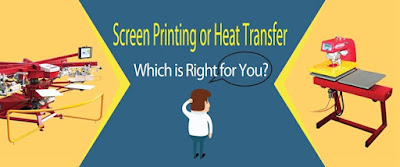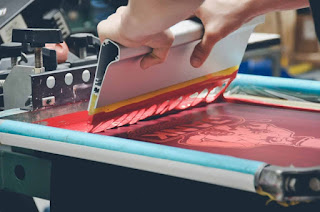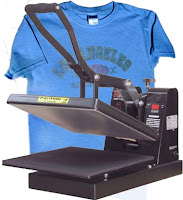Heat Transfer
Heat transfer printing is the exchange of thermal energy between physical systems. The rate of heat transfer is dependent on the temperatures of the systems and the properties of the intervening medium through which the heat is transferred. The three fundamental modes of heat transfer are conduction, convection and radiation.Silk Printing
Method in which ink is applied directly to the surface to be printed (substrate). The image to be printed is photographically transferred to a very fine fabric (the screen) such that the non-printing areas are blocked off and the fabric serves as a stencil. The ink is wiped across the screen to pass through the unblocked pores and reach the substrate. For each color to be printed a separate screen is prepared and the process is repeated. It is more suitable for curved shapes (such as bottles and cups), non-porous surfaces (such as ceramics and metals), and short print runs. |
| Heat Transfer Printing VS Screen Printing |
Silk Printing vs Heat Transfer
When a design is produced using the screen printing method, actual screens are used in the process! Essentially, this screen is cut to make a stencil for the design. Ink is then spread over the screen, passing through to the object underneath only in the areas you want it to be. Only one color per screen can be used - so depending on the number of colors in the design, you’ll need multiple screens to produce the final item.
The heat transfer printing method applies custom designs to items like t-shirts or tablecloths through a process that uses a combination of heat and pressure. Common kinds of transfer printing include vinyl heat transfer and digital print heat transfer. With the vinyl heat transfer process, a machine is used to cut out designs and letters in pieces of colored vinyl. A heat press is then used to transfer each vinyl color of the design onto the object being printed. With digital print heat transfer, the desired graphic is first digitally printed on special heat transfer paper using a solvent ink. This type of ink allows the design to be transferred from the paper to the item being printed when pressed with heat. With both these types of heat transfer, a heat press machine will be needed to transfer the graphic, either vinyl or digitally printed, from one surface to another. It’s the magical combination of heat and pressure that transfers the design!
When to choose silk printing
 |
| Screen Printing |
- Large batches of prints. How large a press run needs to be to make it cost effective versus heat transfers will depend on your heat transfer process, but generally screen printing is most cost effective when press runs are around 100 garments, minimum.
- Special effects printing. Whether it's applying glitter, using puff ink or creating a photo realistic process image, images that go beyond the basics generally call for silk printing.
- Jobs that call for vibrant or dark colors. Often, heat transfers in bright or dark colors don't transfer well, and they're prone to fading over time.
- Prints with a soft hand. Heat transfers can be heavy and plastic-y. If you or your customer wants garments that have a soft hand feel, you generally will need to rely on it.
When to choose heat transfer
Heat transfer machine have flatbed heat transfer machine and rotary heat transfer machine.Heat transfers can be achieved in several different ways. You can use your silk printing press to generate plastic heat transfers to keep on hand for return customers. You can create small batches of designs with a vinyl cutter or inkjet printer to heat transfer quickly and at a relatively low cost. Still, other shops prefer to order heat transfers when they need to create a small-batch job for a customer.- Small batch printing. With heat transfer capabilities, your shop can profitably turn around small batch jobs, without using a lot of labor or tying up your silk printing presses.
- Jerseys or personalized apparel. With heat transfers, you can customize each garment with a name and/or number quickly and easily. Many heat transfer companies even sell letters and numbers just for these types of jobs.
- Oddly shaped substrates. Silk screen printing on bags, ball caps and other irregularly shaped can be challenging to work with on a silk printing press. Heat transfers allow you to easily lay down prints on the most awkward of substrates, and there are many pallets made to hold these hard-to-print substrates.
- Custom artwork. If you want to sell one-off garments featuring custom artwork, heat transfers allow you to create the design in advance, and then apply them to the right size and color garment as orders roll in.
- On-the-go printing. If you are looking to sell custom designs at events, like concerts or festivals, heat transfers allow you to take printing on the go. You just pre-cut or print your artwork, and apply the heat transfers on demand and on the spot with a small heat transfer press.
Website: www.skyimagepaper.com
Company Name: Fei Yue Digital Technology Co.,LTD
E-mail: sales@feiyuepaper.com
Tel: 86-025-86628894
Whatsapp: +86 15007920742
Address: Central Road 323, Nanjing, Jiangsu, China

没有评论:
发表评论